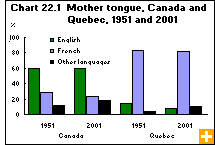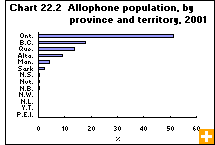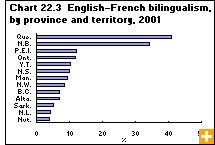Common menu bar links
Language
Archived Content
Information identified as archived is provided for reference, research or recordkeeping purposes. It is not subject to the Government of Canada Web Standards and has not been altered or updated since it was archived. Please contact us to request a format other than those available.
In the 2001 Census, English was the mother tongue for 59% of Canadians, unchanged from 1951, and French was the mother tongue for 23% of us, a decline from 29% in 1951. A mother tongue is the first language learned at home in childhood and still understood.
More than 100 other languages are spoken in Canada, and they can be heard on television and radio, at work, at school, on buses and at the local mall. So words such as donair, siesta, and ciao have found their way into our everyday speech.
After English and French, Chinese is the most commonly spoken language in Canada, followed by Italian and German. In 1971, German was third followed by Italian and Ukrainian. Arabic, Spanish and Punjabi are becoming more common, reflecting Canada’s growing diversity and expanding trade.
Many factors influence how Canadians’ use of language evolves: immigration, interprovincial migration, cross-cultural marriages, fertility rates, legislation and the languages spoken at home and at work.
Language usage and transfer
For most immigrants, English or French soon becomes the language used most often at school or work, even as many strive to maintain their ancestral languages. In the long run, children and grandchildren of immigrants tend to acquire English or French as their mother tongue.
Language transfer—the tendency to speak a language other than the mother tongue at home—can signal a change in the language that will be passed down to future generations within a family.
For example, there has been an increase in language transfer among francophone minorities outside Quebec. In 1971, 30% of francophones outside Quebec spoke a language other than French, usually English, at home. By 2001, this increased to 38%. The transfer rate for francophones varied across the country from 11% for those living in New Brunswick to a rate of 75% in Saskatchewan.
Among Quebec’s anglophone minority, the rate of language transfer was 10% in 2001, an increase from 8% in 1971.
In 2001, one out of six Canadians, more than 5.2 million people, were allophones; that is, their mother tongue was neither English nor French. They represented 18% of the population, up from 12% in 1951.
In Quebec these days, more allophones than in the past are learning and switching to French: 46% transferred to French in 2001, compared with 39% in 1996. In 2001, 73% of allophones could conduct a conversation in French, compared with 69% in 1996. About 54% transferred to English in 2001, compared with 61% in 1996.
The majority of allophones live in Ontario, British Columbia, Quebec and Alberta. Most live in our large cities. Chinese is the main non-official language in Vancouver, Toronto, Calgary, Ottawa and Edmonton. Italian is the main non-official language in Montréal and Windsor. In Winnipeg and Kitchener, it is German. In Abbotsford, British Columbia, Punjabi became the main non-official language in 2001.
Preserving mother tongues
Many immigrants believe that teaching their mother tongue to their Canadian-born children is important. Aside from the cultural value, it provides children with knowledge of another language, strong ethnic identity and enables participation in ethnic businesses and social life.
In the 2002 Ethnic Diversity Study, 64% of adults said they learned their parents’ ancestral language in childhood and 74% of this group could still use it to carry on a conversation. Children were most likely to regularly use their parents’ mother tongue at home if they acquired it early.
As adults, 32% used their parents’ mother tongue regularly in the home. Outside the home, 16% of grown children of recent immigrants spoke their ancestral language regularly with their friends, while 12% of those in the labour market used it regularly in the workplace.
Parents whose mother tongue was Punjabi, Spanish, Cantonese, Korean or Greek were most likely to have children who learned these languages as their mother tongue. Individuals who were part of earlier immigrant groups—including Dutch, Scandinavian, German, Filipino, Semitic and Nigerian-Congolese—were the least likely to pass along their languages to their Canadian-born children.
More of us are bilingual
In the 2001 Census, 18% of the population, or 5.2 million people, said they were bilingual in English and French, up from 17%, or 4.8 million, five years earlier. Nationally, 44% of francophones said they were bilingual in 2001, compared with 9% of anglophones.
Bilingualism is on the rise in Quebec. In 2001, 41% of Quebecers reported being bilingual, compared with 38% in 1996 and 35% in 1991. Anglophones in Quebec have the highest rate of bilingualism of all groups in Canada, and their bilingualism rate has risen, from 63% in 1996 to 67% in 2001. However, the proportion of anglophones has declined from 14% of Quebec’s population in 1951 to 8% in 2001.
In the rest of Canada, however, the rate of bilingualism increased to 10% in 2001, compared with 8% in 1971.





